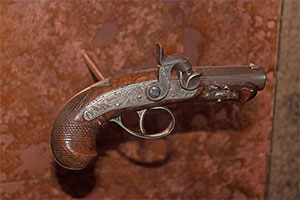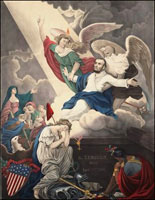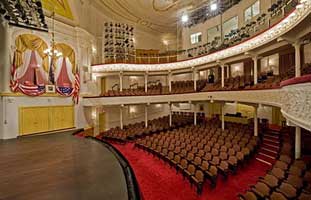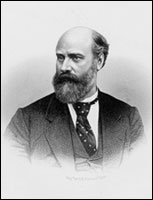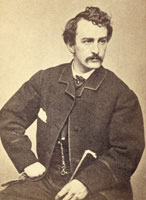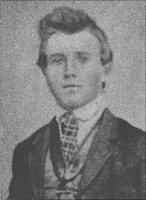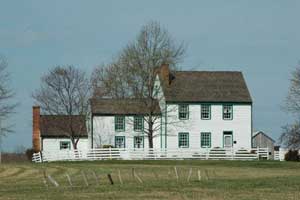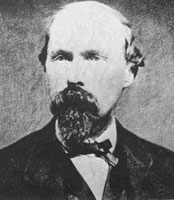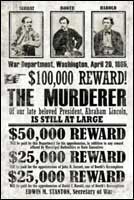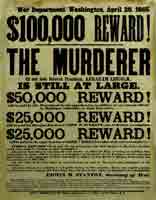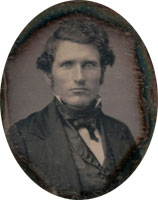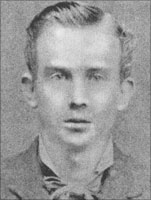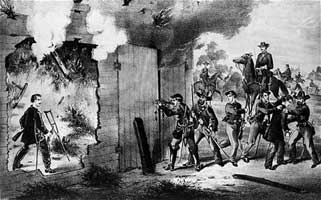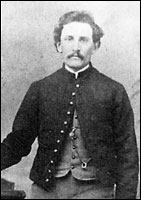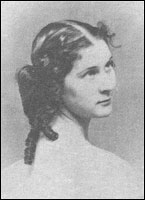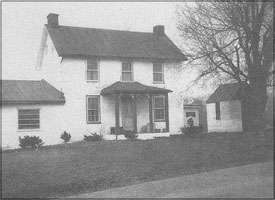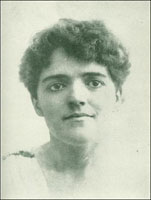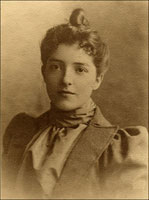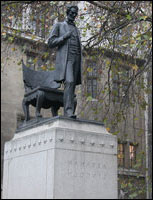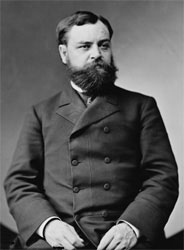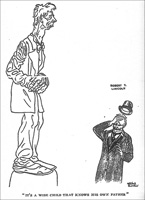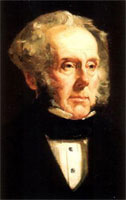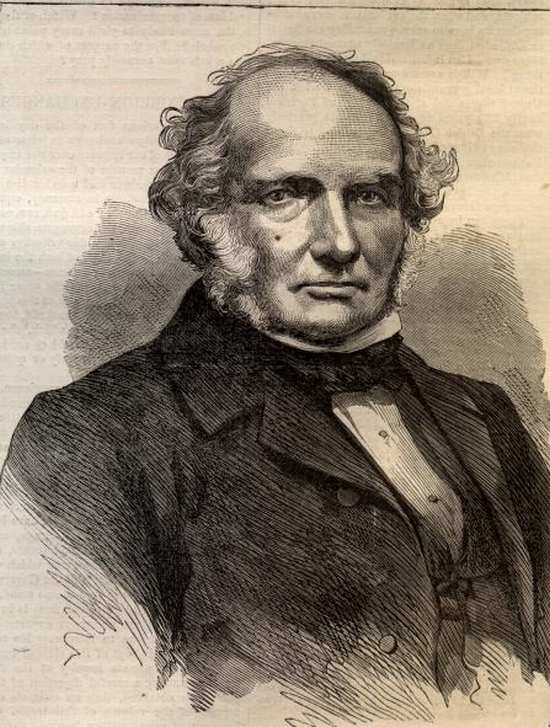The assassination of our beloved President Lincoln happened at Ford's Theatre on April 14, 1865. President Lincoln was a Moses-like and a Christ-like figure. Moses freed 3 millions slaves but died just before he could enter the Promised Land. Christ was betrayed by Judas Iscariot–one of the 12 Apostles–and Lincoln was betrayed by his own "loving" wife Mary.
|
|
The President went to his eternal reward on the morning of April 15.
After Mary fired the fatal shot, Booth jumped to the stage below pulling the flag with him. He shouted "sic semper tyrannus" to the audience as if he was performing in a play!!
Booth's theatrics were designed to distract attention from the real assassin in the Presidential box.
Booth was no small time operative in the strong conspiracy. Booth's great-great-grandfather, Ricardo Botha (Heb. Beth), a "Jew/Jesuit" arrived from Spain via Portugal around 1760 and changed his name to Robert Booth. "Silversmith" Ricardo had unlimited funds from the slave labor silver mines of Mexico to bribe the British government. Booth was also a member of the Knights of the Golden Circle which was just a cover for the Jesuits.
President Lincoln (a David versus Goliath figure) was fighting the Jesuits, the Fenians, the British government, the French government, and the rebels–all at the same time!!
Over 1,000 people saw Booth jump to the stage uninjured!!
Booth had played the role of Brutus in William Shake-speare's Julius Caesar many times. The daggar in Booth's hand was supposed to equate him with Brutus killing tyrant Julius Caesar.
Booth was perfectly suited for the role of fake fall guy or patsy. Physical agility is an essential requirement for a Shake-spearean actor. Over 1,000 people attended Ford's Theatre that night and nobody then remembers Booth limping or lame.
|
Ford's Theatre had a capacity of 2,400 people. That night it was sold out because the President and general Grant were expected to attend.
Frederick A. Sawyer was just one of hundreds of people who gave depositions after the assassination. At that time, none of them mentioned a lame or limping Booth:
The play was "Our American Cousin," with Laura Keene as Florence Trenchard. After sitting through the first act Mr. Bates and myself left the lower part of the house and went up in to the "dress circle," on the opposite side of the house in order that we might get a better view of the President and his party. We staid there some time, when we returned to the seats below and this time I took the chair on the end of the second row from the Stage and as near Mr. Lincoln's box as possible in that row. Mr Bates sat next to me. After sitting there a few minutes a report of a pistol was heard and a man of about 5 ft. 9 inches dressed in a black suit of clothes leaped onto the Stage apparently from the President's box. He held in his right hand a dagger whose blade appeared about 10 inches long. He did not strike the stage fairly on his feet, but appeared to stumble slightly. Quickly recovering himself he ran with lightning speed across the Stage & disappeared beyond the scenes on the Stage "right" our "left." The whole occurrence, the shot, the leap, the escape–was done while you could count eight. The excitement in the house was intense. (Good, We Saw Lincoln Shot, pp. 37-38).
Booth had plenty of time to practice or rehearse the assassination and he left nothing to chance. In English, the term "pulling your leg" means to deceive or lie.
Booth made a very rapid getaway from the theatre and headed to the Navy Yard Bridge. Booth gave his real name to the sentry–sergeant Silas T. Cobb–and he was allowed to cross the Potomac into Maryland.
Booth was soon joined by an accomplice named Edward Henson, and they rode together to the country tavern of Mary Surratt. At the Surratt tavern they stocked up on weapons. and then they made a brief detour to the home of a Maryland physician named Samuel Mudd.
|
Dr. Mudd was a Maryland physician and rebel sympathizer who was well known to John Wilkes Booth. A Booth diary was later providentially found that claimed Booth broke his leg when he jumped from the stage. Spies don't keep diaries.
|
Actors are very familiar with playing roles and disguises; and this actor was running for his life. The most logical move for Booth was to disguise his appearance as much as possible.
|
|
It never occured to Stanton, or the other pursuers, that the most wanted man in the country would try to disguise himself by shaving off his moustache and wearing a beard.
The Booth look-alike killed in the barn!!
After the assassination, the head of Edwin Stanton's secret police named Lafayette C. Baker, began rounding up hundreds of suspects. One of the suspects that fell into his web was a young man named David Herold.
|
Baker, his detectives, and Herold set off for the home of James William Boyd. At that time, Boyd was working as a farmer for a man named Colonel Frank Beale. Boyd did not want to join the Booth manhunt charade, but he had a lot of skeletons in his closet, and he was also threatened with hanging if he did not cooperate.
In 1863, James William Boyd was arrested with 2 other men as Confederates spies. The 2 other men were hanged, but Boyd was turned into a double agent for the Union. Boyd's job was to be a Union informer or a snitch among the rebel prisoners. In February 1865, Secretary of War Stanton released him from the Old Capitol Prison in Washington City and his assignment was to infiltrate a group that was planning to "kidnap" the President.
|
David Herold was with Boyd when the barn was surrounded, but he gave himself up and was spared for later hanging. A later diary of Booth was found that claimed that Booth broke his leg when he jumped from the stage. Spies don't keep diaries.
Reliable sources say that there were 3 men in the barn that night. The mystery man shot Boyd in the back of the neck and then escaped through a secret opening in the back of the barn.
When it came time to identify the body of "Booth," the witnesses saw a man with a red moustache:
The Potters followed Baker along the deck to where guards stood by the corpse. Baker pulled back the old blanket with a flourish. The Potter brothers leaned closer. The dead man wore a long shaggy mustache. It was so long that the reddish-sandy hairs curled upward into his nostrils. The brothers straightened up. "Sure grew a moustache in a hurry. Red, too."
Baker protested, "Everyone knows Booth had a mustache!"
Luther Potter gently replied, "His was black. And Booth shaved it off the night he stopped at Dr. Mudd's. " "My God!" Luther Baker exclaimed. "We got the wrong man!" He raced from the boat to order a fresh mount. "I'm going back to Garrett's farm"
Wait for us!" Andrew called. (Balsiger, The Lincoln Conspiracy p. 247).
The corpse of James William Boyd, a.k.a. John Wilkes Booth, was unceremoniously dumped into a grave in the Arsenal Penitentiary, and that was supposed to close the curtain on President Lincoln's assassin.
Meanwhile, the real Booth, with Henson and a servant named Henry Johnson, found refuge with Booth's wife Izola in the Shenandoah Valley of Virginia.
|
By 1865, Booth had a 6-year old daughter named Ogarita Rosalie, who lived on the Booth farm in the Shenandoah Valley.
|
Ogarita Rosalie married George W. Hills, and in 1937 Booth's granddaughter, Izola Forrester, wrote her autobiography entitled This One Mad Act:
My grandmother had been the daughter of Abram Standish Mills, owner and captain of a trading schooner in the China trade. Her mother, the first Izola, has always been my favorite ancestor–though not, incidentally, because I am her namesake. She had met and loved Captain Mills at some time when he had been in Spain, and after several of his voyages, she had overcome her fear of the sea, and they had been married. After the long months on the trip out to China and back, she had died in giving birth to my grandmother on board ship, in a wild storm off the coast of Martha's Vineyard, almost in sight of her husband's native land. I will tell more of her later on. I mention her now, only to show why my grandmother was taken–almost at birth, by her father's sister, great-great-aunt Fanny D'Arcy of Baltimore, and raised in the South entirely, although her people were all Northerners. (Forrester, This One Mad Act, p. 10).
By November 1865, the furor over the assassination of President Lincoln had died down so Booth and Henson left their hideout and traveled to New York City, where they boarded a steamer for Canada. From Canada, Booth and Henson went to Liverpool, and then to London. Booth's last known address was Bombay, India, where he lived under the alias John B. Wilkes.
The Lincoln "stomach-ache" statue for Parliament Square!!
It is almost beyond belief but there is a statue of President Lincoln in Parliament Square in London. The statue was erected in 1920, and it is a replica of the colossal 1887 Standing Lincoln, in Chicago's Lincoln Park, by Augustus Saint-Gaudens.
The Saint-Gaudens statue was not intended for this spot. It replaced a replica of a controversial statue by George Barnard, previously installed in Cincinnati, Ohio.
|
The grotesque statue was originally carved for a public park in Cincinnati. When Robert Todd Lincoln heard that copies were going to be placed in London and Paris, he was appalled, calling it "simply horrible."
|
The statue was commissioned by a brother of President William Howard Taft:
Only nine days before he gave his address in Cincinnati, President Taft had received a letter from his friend Robert T. Lincoln expressing "great concern" about the statue and asking for Taft's assistance. Robert had viewed photographs of the Barnard statue that winter and was horrified by what he saw. He considered it "a monstrous figure which is grotesque as a likeness of President Lincoln and defamatory as an effigy." Robert had nothing to say about the statue being placed in Cincinnati, but, he told Taft, he had recently learned of a proposition to place copies of it in London and Paris as gifts from Charles P. Taft. Robert had never met the president's brother, and he therefore wrote to his friend "to beg you on my account to intercede with him" and convince him to abandon the project. "That my father should be represented in those two great cities by such a work as that of which I am writing to you, would be a cause of sorrow to me personally, the greatness of which I will not attempt to describe," Robert wrote." Taft responded that he was "greatly distressed" by his friend's letter, but he disagreed with Robert's opinion and the project was too far advanced to be stopped." (Emerson, Giant in the Shadows: The Life of Robert T. Lincoln, p. 383).
Robert Lincoln mobilized public opinion throughout the country, and he finally won the battle against the statue.
Because of his influence, the Saint-Gaudens work was dedicated in London on July 28, 1920. The Barnard statue replica, dubbed the "stomach ache statue" because of the placement of the hands, was banished to Manchester, England.
The Civil War was orchestrated from London and the Prince of Wales was sent on a "goodwill" mission to the United States just before the war.
|
Prince Albert–beloved husband of Queen Victoria–changed a belligerent letter from Lord John Russell to President Lincoln.
That act of human kindness cost him his life, and possibly averted a world war.
President Lincoln was ready to enforce the Monroe Doctrine!!
The occasion has been judged proper for asserting, as a principle in which the rights and interests of the United States are involved, that the American continents, by the free and independent condition which they have assumed and maintain, are henceforth not to be considered as subjects for future colonization by any European powers. (1823, Monroe Doctrine).
President Lincoln knew that ending slavery was only half the job of saving the Union. The other half was ending the northern threat:
In late March 1865, President Lincoln had discussed the Trent affair with General Grant, making it clear that Britain deserved to be punished: "We gave due consideration to the case, but at that critical period of the war it was soon decided to deliver up the prisoners. It was a pretty bitter pill to swallow, but I contented myself with believing that England's triumph in the matter would be short-lived, and that after ending our war successfully we would be so powerful that we could call her to account for all the embassassments she had inflicted upon us." (Forman, A World on Fire: Britain's Crucial Role in the American Civil War, p. 801).
After the war, general Sheridan was sent south to persuade Emperor Maximilian to withdraw from Mexico, but the untimely death of the President allowed the British government to continue their war against the United States from their base in Canada.
Vital links
References Balsiger, David & Sellier. Charles E. The Lincoln Conspiracy. Schick Sunn Classic Books, Los Angeles, California, 1977. Baker, Lafayette C. History of the United States Secret Service. L.C. Baker, Philadelphia, 1867. Eisenschiml, Otto. Why Was Lincoln Murdered? Grosset & Dunlap, New York, 1937. Eisenschiml, Otto. In The Shadow of Lincoln's Death. Wilfred Funk, Inc., New York, 1940. Emerson, Jason. Giant in the Shadows: The Life of Robert T. Lincoln. Southern Illinois University Press, 2012. Foreman, Amanda. A World on Fire: Britain's Crucial Role in the American Civil War. Random House, New York, 2010. Forrester, Izola. This One Mad Act. Hale, Cushman & Flint, Boston, MASS, 1937. Good, Timothy Sean. We Saw Lincoln Shot. University Press of Mississippi. Jackson, Mississippi, 1995. Guttridge Leonard F. & Neff, Ray A. Dark Union: The Secret Web of Profiteers, Politicians & Booth Conspirators That Led to Lincoln's Death. John Wiley & Sons, Inc., Hoboken, NJ, 2003. Hanchett. William. The Lincoln Murder Conspiracies. University of Illinois Press, Urbana, 1983. O'Reilly Bill, & Dugard, Martin. Killing Lincoln: The Shocking Assassination that Changed America Forever. Henry Holt & Co., New York, 2011 Steers, Edward Jr. Blood on the Moon: The Assassination of Abraham Lincoln. University Press of Kentucky, Lexington, Kentucky, 2001. Swanson, James L. Manhunt: The 12-Day Chase for Lincoln's Killer. William Morrow, New York, 2006. |
Copyright © 2016 by Patrick Scrivener
